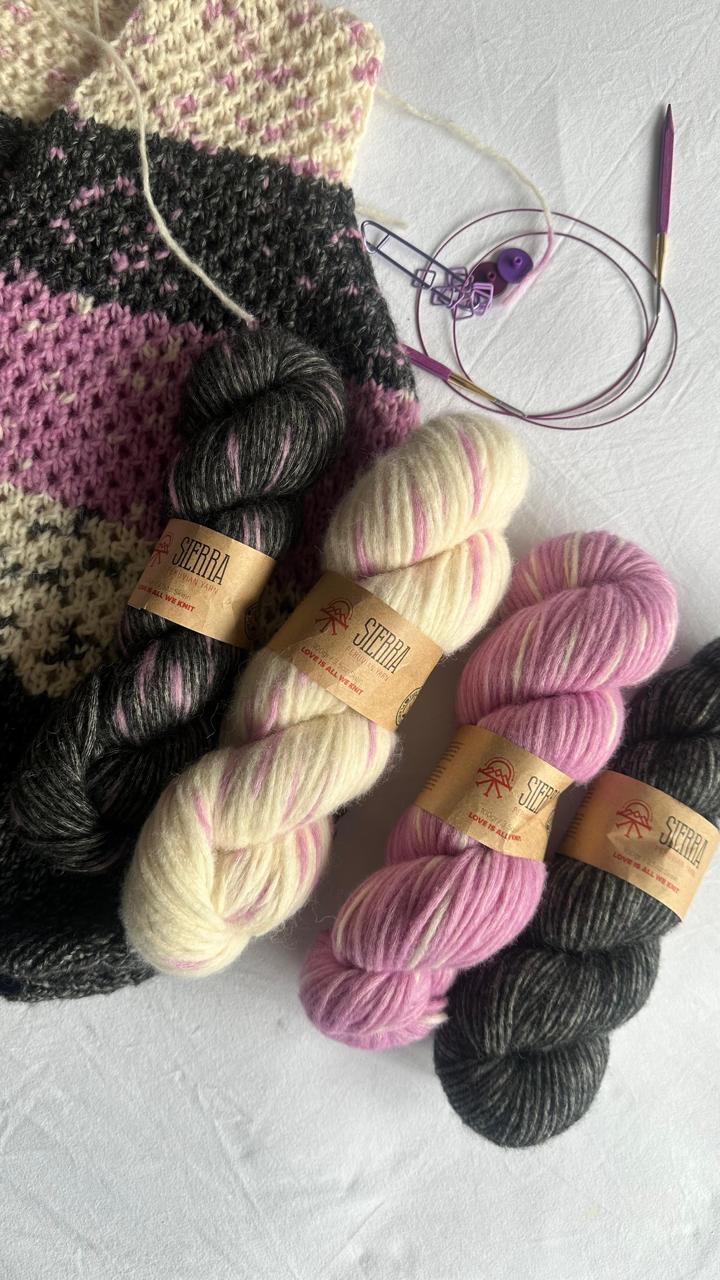Why Knitting Is More Than Just a Hobby—It's Therapy for Your Mind
In our fast-paced, screen-dominated world, finding moments of genuine peace can feel impossible. But what if the solution to stress, anxiety, and overwhelm was as simple as two needles and a ball of yarn?
Knitting isn't just for grandmothers anymore. This ancient craft has evolved into a powerful form of therapy, backed by science and embraced by people of all ages seeking mental wellness. Whether you're dealing with daily stress, anxiety, depression, or simply looking for a mindful escape, knitting offers a unique pathway to emotional well-being.

The Science Behind Knitting as Therapy
How Knitting Calms Your Mind
Research shows that knitting activates the same brain regions as meditation. The repetitive motions create a relaxation response, lowering heart rate and blood pressure while reducing levels of cortisol—the stress hormone that keeps you feeling on edge.
Key mental health benefits of knitting include:
- Reduced anxiety and stress: The rhythmic, repetitive nature of knitting creates a meditative state that quiets racing thoughts
- Improved mood and decreased depression: Completing projects releases dopamine, the "feel-good" neurotransmitter
- Enhanced focus and mindfulness: Knitting requires present-moment awareness, pulling you away from worries about the past or future
- Better cognitive function: Learning new patterns and techniques keeps your brain sharp and engaged
- Chronic pain management: The distraction and focus required can help reduce perception of pain
The Flow State: Finding Your Zone
Psychologists call it "flow"—that magical state where you're completely absorbed in an activity, losing track of time and worries. Knitting is one of the most accessible ways to achieve this therapeutic state. Unlike more complex crafts, knitting's gentle learning curve means beginners can experience flow relatively quickly.
Why Knitting Works When Other Stress Relief Methods Don't
It Gives Your Hands Something to Do
For many people, anxiety manifests physically—fidgeting, nail-biting, or restless energy. Knitting channels that nervous energy into something productive and beautiful. Your hands stay busy, but your mind can finally rest.
You Create Something Tangible
In a world of digital work and intangible results, knitting gives you something real to hold. Every stitch is visible progress. Every row completed is an accomplishment. This tangible sense of achievement is incredibly powerful for mental health, especially when other areas of life feel uncertain or overwhelming.
It's Portable Peace
Unlike yoga classes or gym sessions, you can take your knitting anywhere—on your commute, during lunch breaks, while waiting for appointments, or during quiet evenings at home. Your calm is always within reach.
Getting Started: Your First Steps into Therapeutic Knitting
What You Need to Begin
The beauty of knitting is its simplicity. You don't need expensive equipment or a dedicated space. Here's what beginners should start with:
Essential supplies:
- Yarn: Choose something soft and easy to work with. Avoid anything scratchy or splitty for your first project. Medium-weight yarn (worsted weight) in a light color is ideal—you'll be able to see your stitches clearly
- Knitting needles: Size US 8-10 (5-6mm) needles are perfect for beginners. Start with bamboo or wooden needles as they're easier to grip and yarn doesn't slip as easily
- Basic tools: Scissors and a yarn needle for weaving in ends
Pro tip: Invest in quality materials from the start. Scratchy, difficult yarn can turn a therapeutic experience into a frustrating one. Your first project should feel luxurious in your hands—this isn't the time to compromise on comfort.
Your First Therapeutic Project: The Simple Scarf
Start with a basic garter stitch scarf. This beginner-friendly project teaches fundamental skills while being forgiving of mistakes. The repetitive nature is perfect for achieving that meditative state.
Why a scarf is ideal:
- Simple, repetitive stitching allows your mind to relax
- No complicated shaping or counting required
- Long enough to truly experience the therapeutic benefits
- Creates something useful and giftable
- Mistakes won't ruin the project—they add character
Learning Resources for Mindful Knitting
The knitting community is incredibly welcoming. Take advantage of these resources:
- Video tutorials: Visual learning makes picking up stitches easier to understand
- Local yarn shops: Many offer beginner classes where you can ask questions in real-time
- Knitting groups: The social connection enhances mental health benefits
- Online communities: Connect with fellow knitters for support and inspiration
Creating Your Knitting Ritual: Maximizing the Therapeutic Benefits
Set the Scene for Success
Transform knitting into a true self-care practice by creating the right environment:
Design your peaceful knitting space:
- Find comfortable seating with good lighting to reduce eye strain
- Eliminate distractions—put your phone on silent or in another room
- Create ambiance with soft music, nature sounds, or complete silence
- Keep a cup of tea or water nearby
- Use this time as your sacred "me time"
Establish a Consistent Practice
Like meditation or exercise, the mental health benefits of knitting compound with regular practice. Even 15-20 minutes daily can make a significant difference in your stress levels and overall well-being.
Tips for building a knitting habit:
- Choose the same time each day—morning coffee, lunch break, or before bed
- Start small—commit to just 10 minutes if you're busy
- Keep your project visible and accessible as a reminder
- Track your progress to maintain motivation
- Be patient with yourself as you learn
Beyond Stress Relief: The Deeper Benefits of Therapeutic Knitting
Building a Sense of Accomplishment
Depression and anxiety often rob us of confidence. Knitting rebuilds it, one stitch at a time. Every completed row proves you're capable. Every finished project is evidence of your skill and persistence.
Connecting with Others
While knitting can be a solitary, meditative practice, it also opens doors to community. Knitting circles and online groups provide social connection without the pressure of constant conversation—you can be together while focused on your work. This gentle socialization is perfect for those who find typical social situations draining.
The Joy of Gifting
Creating something with your own hands for someone you love is deeply meaningful. The act of gift-giving releases oxytocin, strengthening bonds and boosting your own happiness. Knowing your finished scarf, hat, or blanket will bring warmth and comfort to another person adds purpose to every stitch.
Mindfulness in Motion
Unlike seated meditation, which some find difficult, knitting gives your body gentle movement while achieving the same mental clarity. For those with restless energy or ADHD, this active meditation can be more accessible and sustainable than traditional stillness.
Common Beginner Challenges (And How to Overcome Them)
"I Keep Making Mistakes"
Perfect. Mistakes are part of the process, not signs of failure. In knitting, most "mistakes" are barely noticeable in the finished piece. The therapeutic benefit comes from the process, not perfection. Learn to embrace imperfection—it's part of what makes handmade items special.
Mindset shift: Every dropped stitch is a learning opportunity. Every uneven row shows progress from where you started.
"I Don't Have Time"
You don't need hours of free time. Knitting fits into life's small moments—waiting for water to boil, during TV commercials, or while listening to podcasts. Those 5-minute pockets add up. One row here, two rows there, and suddenly you've completed a project.
"My Work Looks Nothing Like the Pictures"
Your first project won't look professional—and that's completely okay. The mental health benefits are identical whether your scarf is perfectly even or slightly wonky. Focus on how knitting makes you feel, not how it looks.
"I'm Too Stressed to Learn Something New"
This is the paradox—we often resist self-care when we need it most. Start with watching just one tutorial video. Pick up needles for five minutes. Lower the pressure by reminding yourself this is about the calming process, not mastering a new skill immediately.
Choosing the Right Yarn for Therapeutic Knitting
Your yarn choice dramatically impacts your knitting experience. For therapeutic purposes, prioritize how the yarn feels over how it looks.
What Makes Yarn Therapeutic
Softness is non-negotiable: Your hands will be touching this fiber for hours. Scratchy, rough yarn creates sensory discomfort that counteracts relaxation benefits. Look for yarns described as "buttery," "cloud-like," or "silky."
Ease of use matters: Avoid yarn that splits easily or snags constantly. Fighting with your materials creates frustration, not flow. Smooth, well-made yarn glides through your fingers effortlessly.
Natural fibers feel different: While synthetic yarns have their place, natural fibers like alpaca, merino wool, and cotton provide a sensory experience that many find more grounding and pleasurable. The connection to natural materials can enhance the meditative quality of knitting.
Color psychology: Choose colors that speak to you emotionally. Calming blues and greens, energizing yellows and oranges, or sophisticated neutrals—your color choice affects your mood while knitting and when wearing the finished piece.
Investment in Self-Care
Quality yarn is an investment in your mental health. When you work with materials that feel luxurious, knitting transforms from a task into an indulgent self-care ritual. You're worth the investment.
Making Knitting Part of Your Mental Health Toolkit
Combining Knitting with Other Wellness Practices
Knitting doesn't replace professional mental health care, but it's a powerful complementary practice:
- With therapy: Many therapists recommend knitting as homework between sessions
- With medication: Knitting provides drug-free symptom management alongside prescribed treatments
- With exercise: While different from physical activity, knitting offers mental rest after workouts
- With journaling: Reflect on your feelings while your hands stay busy
Recognizing When Knitting Helps Most
Pay attention to patterns. Many knitters find their practice most beneficial:
- During anxious periods when thoughts race
- When feeling depressed and needing gentle accomplishment
- During life transitions or uncertain times
- While recovering from illness or injury
- As a healthy alternative to scrolling social media
Your Invitation to Begin
You don't need to be crafty. You don't need artistic talent. You don't even need to finish a project. You just need to be willing to try.
Start small. Pick up needles and yarn. Cast on a few stitches. Feel the rhythm. Notice your breathing slow. Watch your shoulders relax. This is your moment of peace, created by your own hands.
The therapeutic benefits of knitting aren't found at the finish line—they're woven into every single stitch. Your journey to calmer, more mindful living begins now.
Ready to experience knitting as therapy? The most important step is starting. Be patient with yourself, enjoy the learning process, and remember: every expert knitter was once a beginner holding needles for the first time.
HERE, you can find some beginner kits for you to start the right way!
Have you tried knitting for mental health? What benefits have you experienced? Share your story in the comments below—your experience might inspire someone else to pick up needles and discover their own path to peace.


